For all the talk by politicians about optimism and the bright future ahead, many of the students I teach are not buying it. A growing number among them are telling me they are not planning to have children. Their decision isn’t selfish. It stems from the multiple worries they have about things like accelerating climate change, gross economic and social inequality, and the normalization of hate.
I agree with them that there isn’t much reason to be optimistic about the future. But this doesn’t mean they can’t be hopeful. Hope and optimism are not the same thing.
I’ve studied social and environmental movements for three decades and am now helping lead a major research university’s efforts to address climate change. This experience has taught me that optimism can actually get in the way of creating a just and hopeful future.
The problem with optimism is that it is a status quo concept. It assumes that even if present times are bad, the future will eventually and somehow turn out all right. Why? A common refrain is that some person or some new technology will come along and save us. At its core, an optimistic attitude believes that the current order is basically sound, trustworthy and deserving of our commitment.
Most of the people I talk to are not convinced of this. Some even say that optimism is dangerous, because it prevents us from correcting the conditions that create so much despair in the first place.
So how is hope different?
Hopeful people do not assume that everything is going to be all right. They see the current trouble and expect that more is on the way. That makes them honest. Hopeful people also resist efforts to predict the future, because nobody knows exactly how things are going to turn out. That makes them humble.
In addition to honesty and humility, a crucial characteristic of hopeful people is courage. Seeing the trouble, facing the pain and suffering, they do not withdraw or become bystanders who assume others will take care of the situation. Instead, they work to create a world better than the current one. It takes courage and a creative imagination to picture what by current standards appears to be an impossible future. It takes resolve not to give up when obstacles to that future come along.
That makes love the essential power that inspires and animates authentic hope. Without the activation of love, hope withers and dies. I don’t mean the sentimental love that, like optimism, assumes a smooth and tidy world that is easy to embrace. Rather, the love that energizes hope is often accompanied by sadness and lament; it grieves the damage done to this lovely world. It often takes the form of protest and resistance, because it demands an end to the wounding of life.
I am inspired daily by the many people I meet who want to give themselves to the creation of a just and beautiful world. They are building community gardens that invite their neighbors to share in the work and enjoy the delicious food they grow together. They are walking the southern border, looking for migrants who need help and protection. They are volunteering for relief efforts when extreme weather hits.
These people are witnesses to hope, because they are nurturing spaces and times in which love and beauty can grow. In a world saturated with suspicion and hostility, these people light a way of hope, because they are agents of hospitality. If hope has a future, it will be because people are committed to the creation of hospitable homes and communities in which all people are welcome.
But I am also chastened by the young people who tell me that my generation has been far too selfish and shortsighted. We are delinquent in our care of school buildings, neighborhood parks and watersheds. We have not designed or invested in infrastructure — those projects that demonstrate our love for the children and grandchildren. We have lived as if the interests of future generations don’t matter.
When I teach about the degradation of our lands and waters or the abuse and abandonment of many of the world’s communities, it is easy to feel depressed. I am regularly asked, “What gives you hope?” My best response is to point to examples of people who are fiercely committed to nurturing and protecting the communities and places they love. When people give themselves to the care of each other, they don’t only inspire others to do the same. They also cast a vision for a future that is worthy of our commitment.
Love is the power that repairs and heals our wounded world. By committing ourselves to magnifying and extending this power wherever we are, we choose hope.
Without the activation of love, hope withers and dies.
It was dark when a group of volunteers arrived at Bethlehem Farm, a Catholic community in the hills of West Virginia.
As their minivans pulled into the gravel parking lot outside the farm’s main house earlier this fall, the 10 students from the University of Notre Dame were met by the farm’s full-time caretakers, who extended the customary Bethlehem Farm greeting: a “welcome home” hug.

“Those were the hardest hugs I’ve ever had in my life,” said Matthew Dunne, the only freshman in the group. “My initial reaction was, ‘What have I gotten myself into?’”
Mark Van Kirk, a junior studying computer science, was also startled.
“I felt like I was being treated like a close friend,” he said. “I don’t normally experience that with strangers.”
Eric Fitts, Bethlehem Farm’s director, said that surprising hospitality is exactly why hugs have become such a part of the central Appalachia farm’s culture.
In what ways could you offer “surprising hospitality” to your neighbors? What gesture fits the culture of your organization?
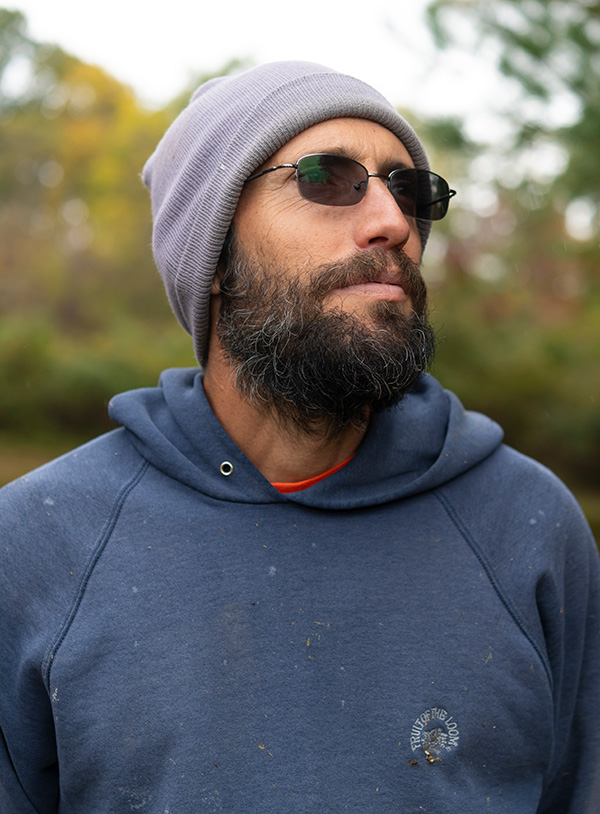
“We do that as a symbol of Christ in each person. What would we do if Jesus showed up on the property today?” he said. “It’s also a way of making ourselves vulnerable. When you open your arms, they’re not stiff out in front of you.”
Located in rural Summers County, Bethlehem Farm describes itself as an intentional Christian community based on “the Gospel cornerstones of service, simplicity, prayer, and community.” A group of caretakers lives and works together year-round, growing a lot of their own food, conserving as much water and electricity as possible, dressing modestly and largely eschewing technology.
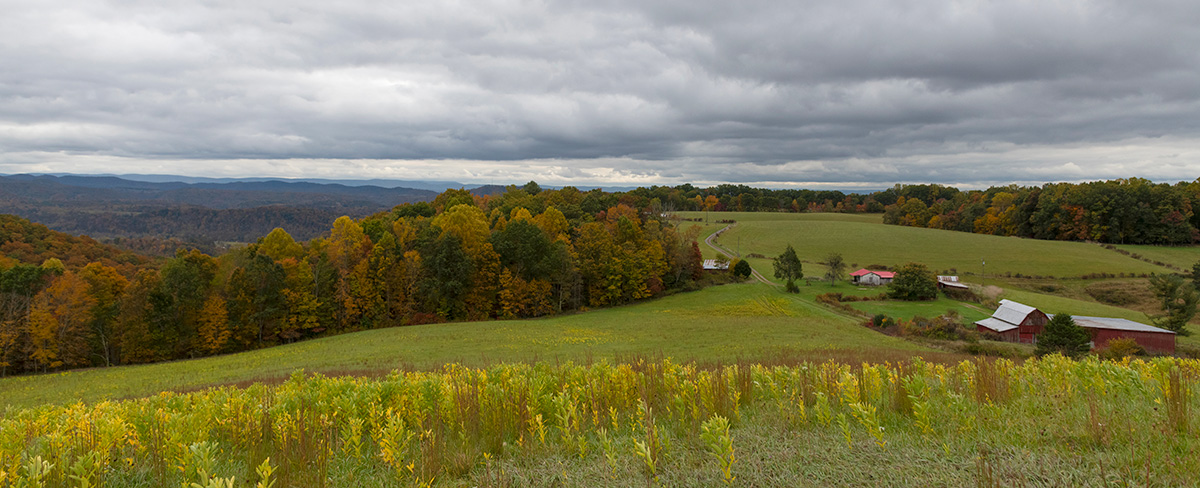
‘Simplicity is countercultural’
The farm welcomes hundreds of volunteers each year for weeklong retreats, where visitors work alongside the caretakers and mirror their way of life. Fitts said the farm’s model of hosting volunteers is in part for practical reasons — it brings in more hands to accomplish the work. But it also allows those volunteers to see mindful, intentional living with their own eyes.
“Whether it’s community living or the idea that simplicity is countercultural — it’s not the way, but it’s a possibility,” he said.
The Notre Dame students were on a midterm break, and all were enrolled in the school’s Appalachia Seminar. On their first morning, Fitts gave them a grand tour of the property. The land once belonged to the Kirwan family, who ran a Catholic Worker farm on the site from 1983 until 2004. The Bethlehem Farm organization formed there in 2005, although the land was then owned by the Diocese of Wheeling-Charleston.
What would simplicity — or a more simple life — look like in your context?
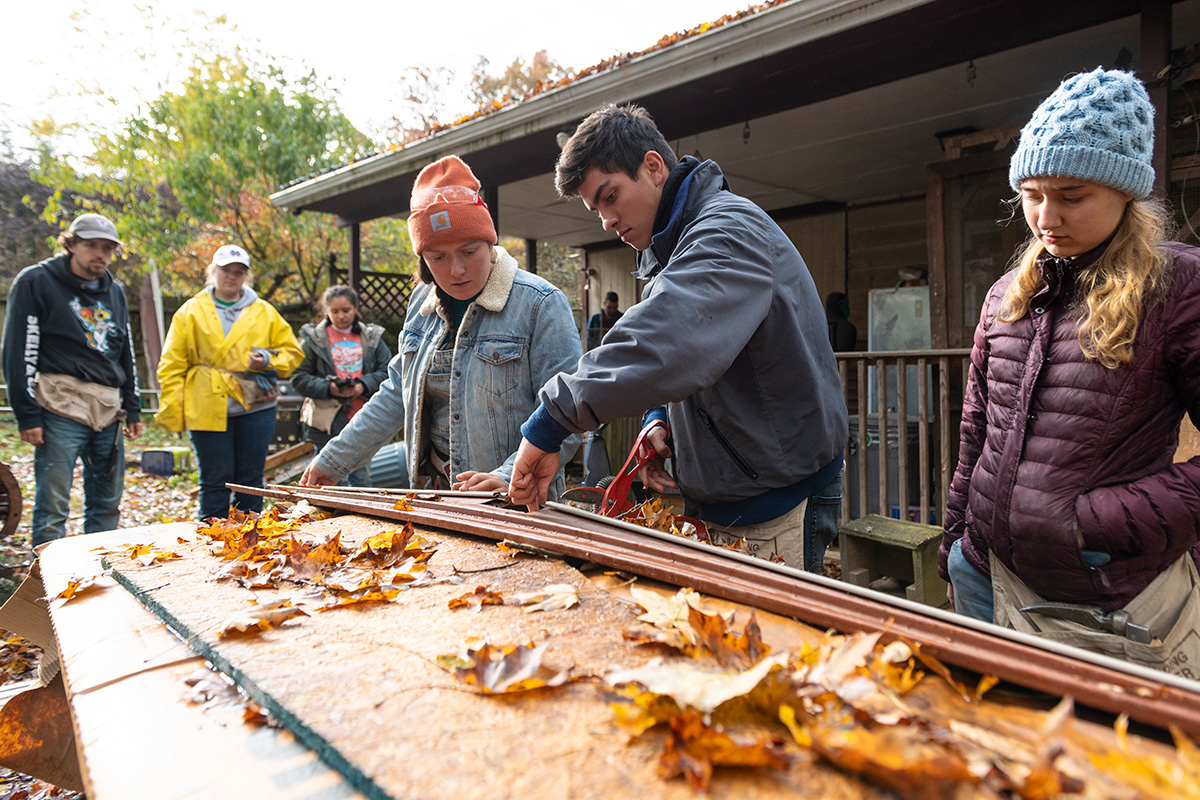
Fitts, a Wisconsin native, discovered Nazareth Farm in north central West Virginia while in college at Loyola University Chicago. Nazareth Farm is another Catholic community that emphasizes prayer, simplicity, community and service and offers service retreats for groups around the country. He fell in love with the way of life there and continued to organize trips to Nazareth Farm after going to work for Wheeling Jesuit University. During one such trip, the idea for Bethlehem Farm was born.
Fitts and others realized there were far more groups on the waiting list for Nazareth Farm than the organization could host. In addition, they wanted a farm that emphasized sustainable practices, which was not a focus of Nazareth Farm at the time. And they believed West Virginia needed more intentional communities.
“There was a neighbor who kept saying, ‘There needs to be more Nazareth Farms,’” Fitts said.
The diocese turned over the property to Bethlehem Farm in 2019.
The farm covers 91 acres, but only a small part is developed. Just below the house is a large pasture, where five donkeys take care of the grass. There are beehives that Fitts’ wife, Colleen, tends. The farm cemetery sits on a hill just above the pasture.
A little way off is the chicken house with its 45 unusually aggressive hens. There are high tunnels (also known as hoop houses), greenhouses, and garden plots of herbs, sweet potatoes, peppers, tomatoes, onions, and just about everything else that will grow in this climate.
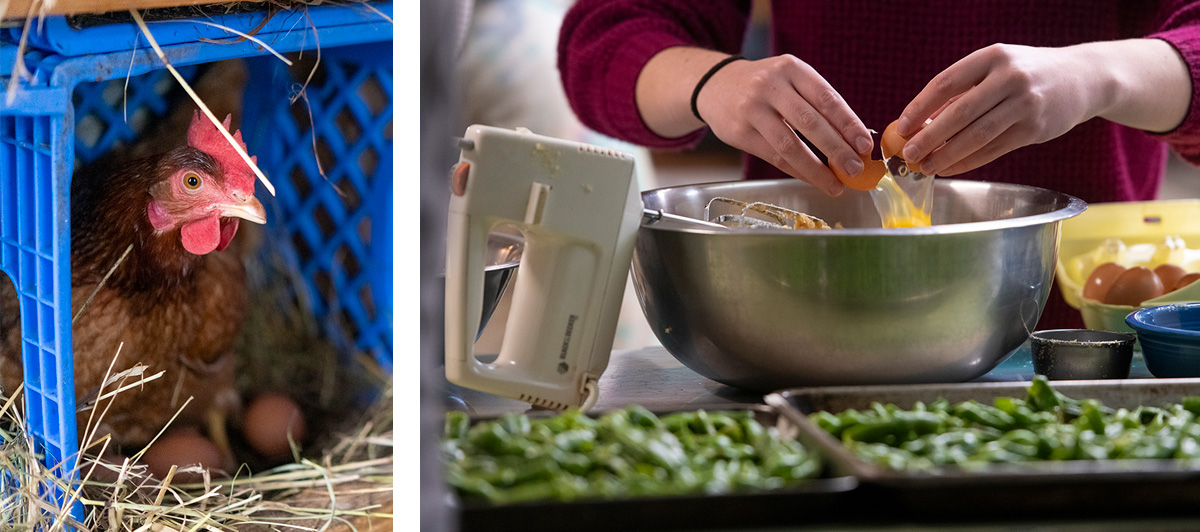
The two residences on the property — one for caretakers, the other for retreat guests — are as eco-friendly as possible. There are solar panels on the roofs. The large, homey cabins are heated by wood-burning stoves, and the plumbing is connected to a rainwater containment system with a capacity of nearly 50,000 gallons. But caretakers still limit themselves to two showers a week, and guests are invited to do the same. There are signs in the bathroom advising guests to flush toilets only when necessary.
In the kitchen, food scraps get composted into fertilizer. There’s not a disposable plate or cup in sight. When guests arrive, they choose coffee mugs and label them with masking tape — to use for the remainder of their stay. Although breakfasts and dinners are made fresh every day, lunches on the farm are a smorgasbord of leftovers.
“I told my dad these people would probably survive the longest in a zombie apocalypse,” Dunne, the freshman, said. “They would survive and be happy.”
Fitts said it’s all just part of the community’s attempt to live out the Gospels.
“When we say we’re living the gospel, I guess the question is — ‘How?’ I think in our culture right now, the default is you’re going to be living destructively: toward the environment, toward yourself, toward other people,” he said. “We’re looking to live creatively.”
Home repair and evening prayer
During their time on the farm, the students split into three work groups. Each day, two groups would work on construction projects with the farm’s Repairing Homes, Renewing Communities program, which provides free labor for home construction projects and allows clients to pay for materials with no-interest loans. The remaining group would serve as that day’s “home crew,” preparing meals, cleaning the residence and planning evening prayer.
What actions could you or your organization take to “live creatively”?
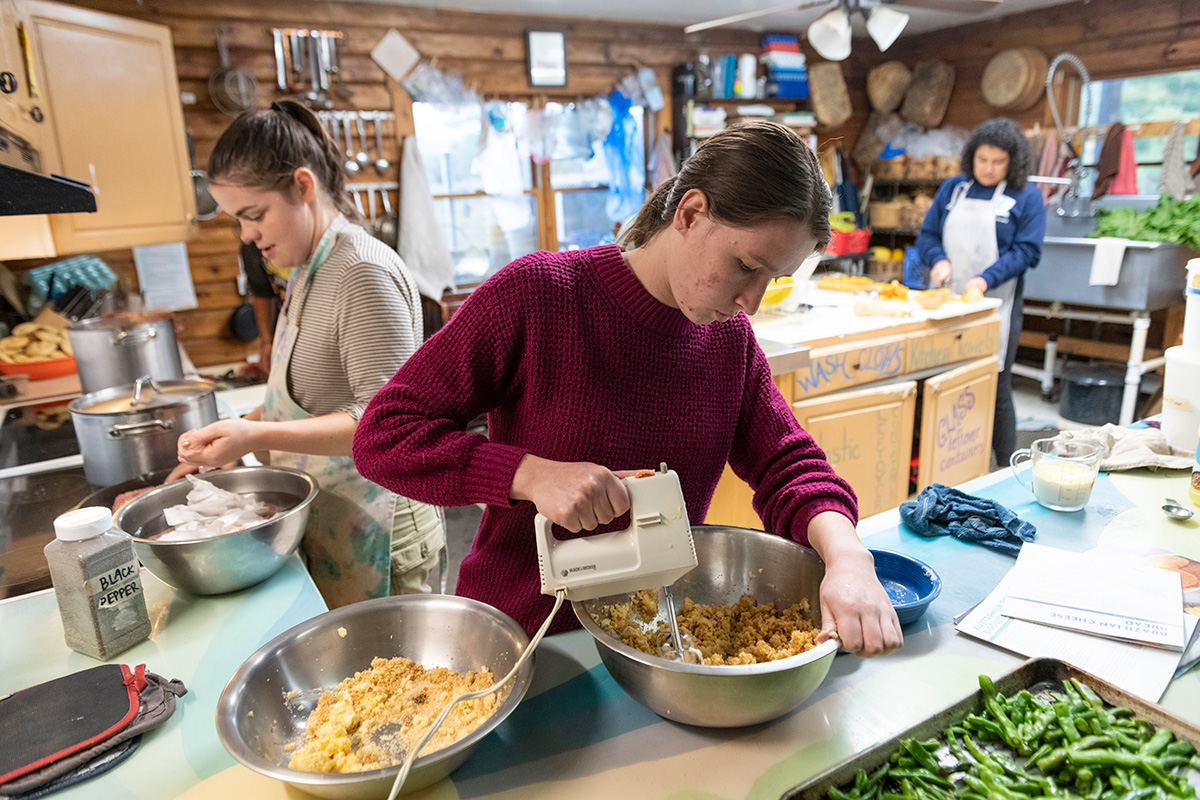
Two projects were underway when the college students visited. At one site, crews repaired a leaky roof by covering it with a new one made of metal. At the other, they measured, cut and installed new vinyl siding on a home.
Bethlehem Farm has other initiatives that go hand in glove with their home repair program. Its Sustainable Upgrade Fund allows families to use more durable, nontoxic and environmentally friendly materials in home projects for no additional cost. Its weatherization program helps homeowners insulate their homes to save on heating and cooling costs. And its renewable energy program gives low-income families 0% financing on solar panels. Volunteers help with all those projects except the installation of solar panels, which is done by professional contractors.
During groups’ first day at the farm, though, no one heads out to a work site. That day is spent doing some chores around the property and learning about the farm — and, more importantly, learning about Bethlehem Farm’s philosophy of service.
“So that we understand we’re not here to reach down a hand and lift up the ‘lowly poor,’” Fitts said.
While there was a renewed interest in helping poor Appalachians during the War on Poverty of the 1960s and 1970s, that assistance came with exploitation, Fitts said. The people of the region were often portrayed as uneducated, helpless and dirty, in need of outsiders to come and fix their issues. Bethlehem Farm is cautious not to perpetuate those stereotypes.
“We are coming with our poverty — the spiritual neglect in much of our culture, the poverty of ‘I’ve never pushed a wheelbarrow.’ And we come with our wealth, our strength, whatever it is we’re giving,” he said.
He emphasizes to students that the people Bethlehem Farm serves have their own poverty and challenges but also their own wealth — life experience, depth of faith, technical know-how, knowledge of local traditions.
That’s why Bethlehem Farm prefers not to use the term “clients” for the people it helps but rather “homeowners,” “partner families” or, even better, “neighbors.”
“Neighbors help neighbors. That’s a really strong trait of West Virginia,” Fitts said. “We just happen to be the neighbor who has 20 college kids come and visit.”
Are there nonmonetary ways for you to assess your community’s poverty and wealth? Your organization’s?

‘Small things’
Maria Vaquero, a junior education major, thought she would enjoy construction projects the most but wound up preferring her day on home crew duty. She packed lunches for the other crews and baked a cake for another student’s birthday.
“I’m a baker. I love to bake,” Vaquero said. “It’s a way of loving people.”
Vaquero still thinks about a quote — often attributed to Dorothy Day — that Bethlehem Farm house manager Molly Sutter lettered above the kitchen cabinets: “Everyone wants a revolution, but no one wants to do the dishes.”
“I think it talks about their simple way of lifestyle,” Vaquero said. “They might get criticism of how much of an impact they’re having — ‘What difference does it make?’ But it’s in the small things.”
That focus on “small things” comes through in Bethlehem Farm’s emphasis on prayer, which begins each day for the group.
“It wasn’t 30 hours of prayer. It was two minutes. And then it changed your perspective on the work you’re doing,” Vaquero said.
“We were on God’s time — that’s what they would tell us,” Dunne said. “We would start prayer while it was dark, and by the end of prayer, it was light. You could really feel time passing.”
The group prayed again before breakfast. They prayed before leaving the farm to head out to work sites and again when they arrived at the work sites. They prayed before lunch, before dinner and before bed.
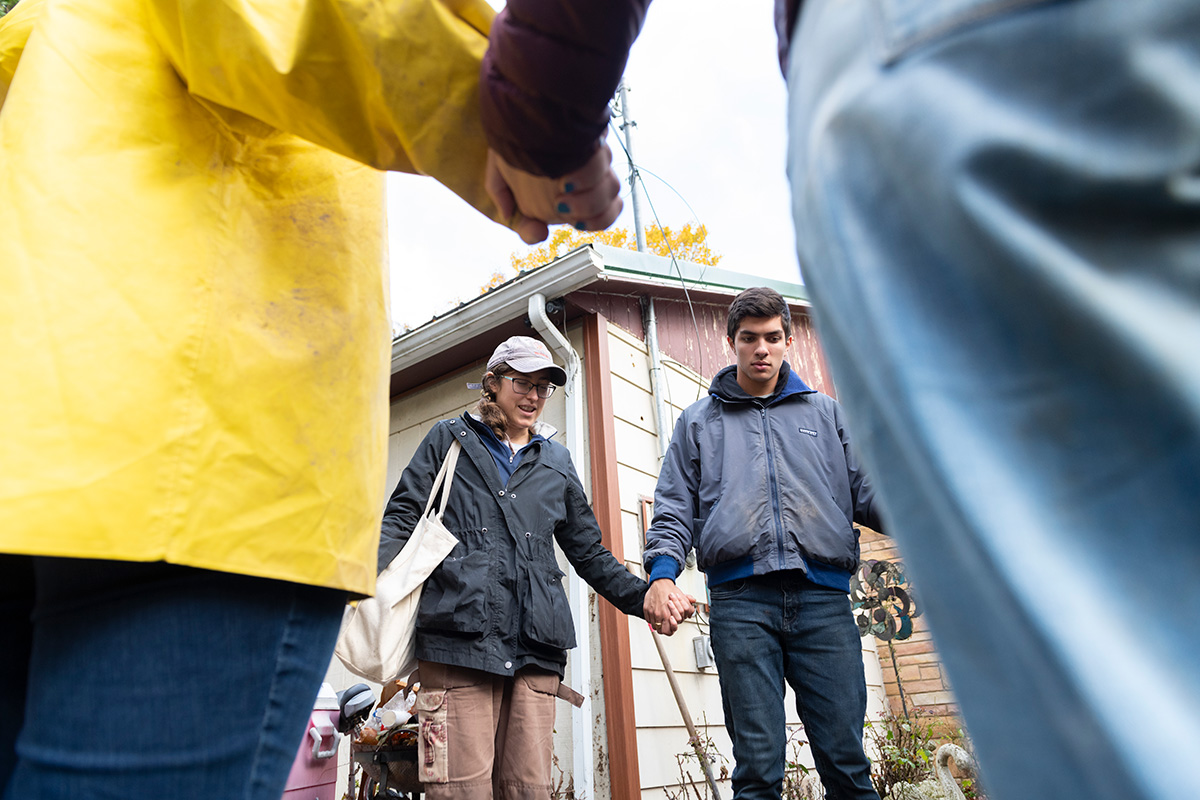
For junior Van Kirk, the emphasis on prayer helped him stay focused on the reason they were there.
“It made our work feel like it wasn’t just work. It felt like it was very purposeful,” he said.
The farm has another way of fostering connection among volunteers — by asking them to fast from technology during their stay. Cell service isn’t great on the property anyway, but the students said they initially found the lack of screens a little difficult.
“I remember, at the beginning of the week, every time I would stand up from a couch I would pat myself and check if I had my phone,” Vaquero said.
But as the week went on, she noticed that the lack of phones changed how she and her peers interacted.
“It forced us to be with one another,” she said. “I’ve realized after the trip, in group settings where there’s nothing to do, people look at their phones and scroll mindlessly. But [at the farm] there was no moment of silence unless it was prayer time. Someone would find something to talk about.”
What “small things” matter in your organization?

Since returning to campus, Dunne has been thinking about how limiting screen time can make him more present with those around him — the way the people at Bethlehem Farm are, he said.
“They’re teaching us what it feels like to be part of a community,” Dunne said. “I could re-create that in my life.”
Gathered in a circle
Every Tuesday night, Bethlehem Farm hosts a community dinner. It’s open to anyone who wants to attend, but caretakers have a list of people they call each week to invite: neighbors they’ve helped in the past, members of the church they attend, other people from the community.
On the week that the Notre Dame students were there, about 40 people showed up. They filled every seat at the multiple dining tables, leaving a few guests to take a seat on couches and coffee tables.
The home crew worked on dinner all day, preparing sausage lasagna, butternut squash, garlic knots, gluten-free cheese rolls, Brussels sprouts, salad greens. One of the guests brought a Little Caesars Hot-N-Ready pizza, which the kids in attendance quickly devoured.
Would you consider fasting from cellphone use as a spiritual practice? What might be the obstacles and benefits?
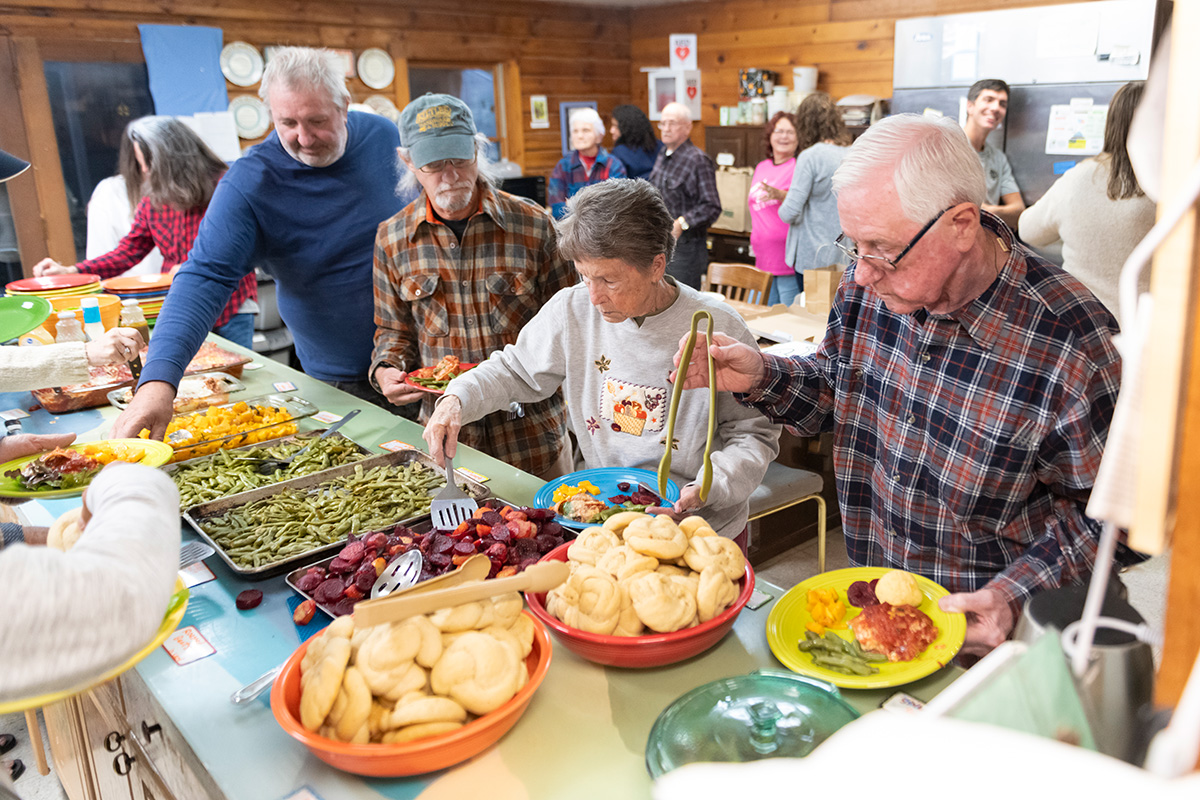
But before dinner was served, everyone gathered in a circle in the center of the room. One by one, they introduced themselves and talked about their connection with the farm.
Among those in the circle were Catherine Wheeler and her mother, Bobbie. They had been introduced to the farm through its home repair program — crews had fixed the gutters, porch steps and shower at Bobbie’s house. She now comes to the dinners almost every week and enjoys the opportunity to socialize with people from her community. Bobbie suffers from COPD and Alzheimer’s disease, and Wheeler, as her mother’s full-time caretaker, doesn’t get many opportunities to interact with other people. She said Bobbie enjoys the meals too.
“I can mention we’re going to dinner at the farm, and she’s ready to go,” Wheeler said.
Near the end of the circle stood Maury Johnson of Summers County Residents Against the Pipeline — SCRAP, for short. He was making his first visit to the community dinner, but SCRAP has been working with Bethlehem Farm for months to protest the Mountain Valley Pipeline project. The natural gas pipeline, which will span more than 300 miles from northwestern West Virginia to southern Virginia, doesn’t directly affect Bethlehem Farm but will run through neighboring properties. And the project’s largest stream crossing is just down the road.
“Bethlehem Farm has been protectors of this river for a long time,” Johnson said. “They’re not boastful. They don’t say, ‘Look at me.’ They just do it.
“The world needs more Bethlehem Farm,” he said.
Around the circle, heads nodded in agreement. Then all present bowed their heads and prayed.
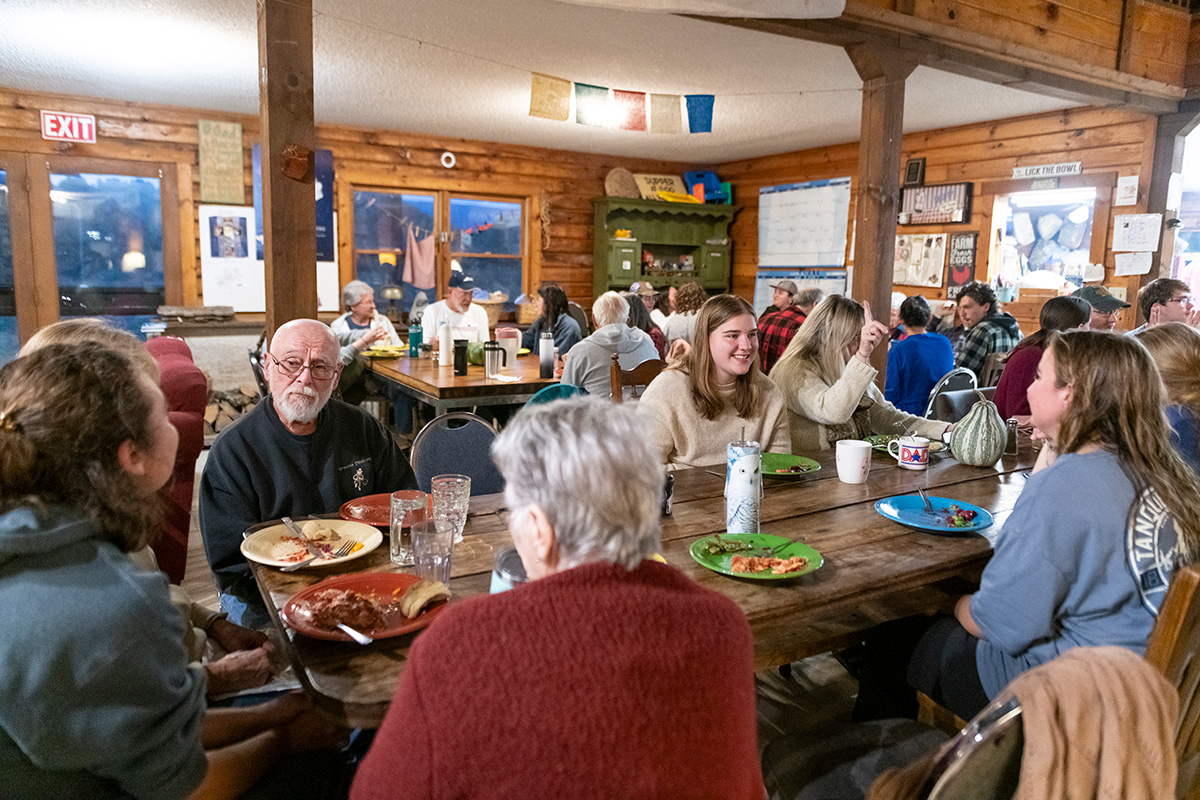
Questions to consider
- In what ways could you offer “surprising hospitality” to your neighbors? What gesture fits the culture of your organization?
- What would simplicity — or a more simple life — look like in your context?
- Bethlehem Farm takes a specific approach to living out the Gospels. What other actions could you or your organization take to “live creatively”?
- Are there nonmonetary ways for you to assess your community’s poverty and wealth? Your organization’s?
- What “small things” matter in your organization?
- Would you consider fasting from cellphone use as a spiritual practice? What might be the obstacles and benefits of such a practice?
From its founding in 1868 as a parish to serve formerly enslaved people, St. Ambrose Episcopal Church has borne physical witness to the gifts and challenges of place.
The Raleigh, North Carolina, church was first located in Smoky Hollow, an area near downtown set aside for freed Blacks where few people wanted to live, because — as the name described — it lay in a valley polluted by smoke from passing trains.
In 1900, when the city decided it needed the church’s land for a mill, St. Ambrose was forced to move its building, rolling it on logs a mile south.
In the early 1960s, St. Ambrose moved again, to follow a growing Black community hemmed in by housing restrictions. Many of the families had relocated to a community called Rochester Heights about two miles to the southeast.

The only site where the city allowed the church to build, though, was in a flood plain. Walnut Creek, which ran through the area, was prone to overflowing its banks. Worse, the city had dumped raw sewage into the creek for almost 70 years before St. Ambrose constructed its new building alongside it. The city had stopped that vile practice, but the area was such a mess that some people had begun using the creek and surrounding land as an unofficial dumping ground.
St. Ambrose’s history has made it very open to the environmental justice movement, said the Rev. Jemonde Taylor, the rector of the 400-member church.
“We were born out of environmental injustice,” Taylor said. “The city dumped sewage; [others] dumped garbage. Then they dumped Black people.”
Among the church’s efforts was the creation of Episcopalians for Environmental Justice in 1996. The nonprofit group involved itself with cleaning up the creek and surrounding wetlands. Taylor said they removed tires, refrigerators, medical equipment, even cars.
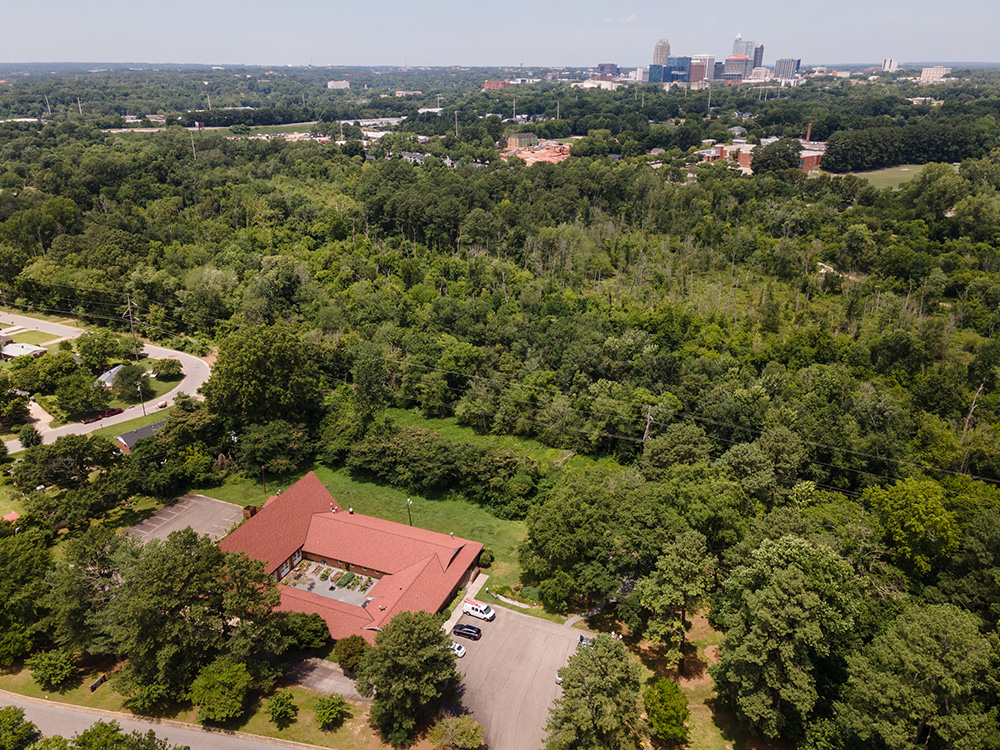
The church sees such work as part of a biblical mandate to be good stewards of the Earth, combined with commands to atone for sin, Taylor said.
“For us, this has not been just a theological exercise; it’s survival.”
Toward environmental justice
St. Ambrose is at the forefront of efforts to get Christians more involved in environmental causes. Often called creation care, such efforts include advocating for policies to stem climate change, encouraging recycling and a green lifestyle, and preventing and cleaning up pollution.
The fight for environmental justice emerges amid the growing struggle in faith communities to recognize and atone for the church’s role in systemic oppressions. In this case, the movement works to ensure that environmental hazards do not fall disproportionately on communities left vulnerable by discrimination and oppressive policies.
Among indigenous communities, for example, deeply grounded religious commitments to the earth continue to be undermined by ongoing harms rooted in colonial abuses. Just last month, the Supreme Court’s ruling against the Navajo Nation regarding water rights that must be negotiated with the state of Arizona has day-to-day implications for the one-third of families on the reservation who lack access to clean, piped water. An already existing crisis there has been exacerbated by a regional drought.
How does the interconnected harm of climate emergency and environmental injustice show up in the landscape of your church or the nearby land? How can your congregation participate in its healing?
Leaders in environmental justice efforts say they are making progress but that their message isn’t always easily accepted. A public opinion poll taken in April 2022 by Pew Research Center threw light on the challenges.
The poll asked respondents how they felt about this statement: “God gave humans a duty to protect and care for the Earth.” Christians overwhelmingly agreed; 92% of those who described themselves as highly religious (those who pray each day, regularly attend religious services and consider religion very important in their lives) expressed support.
But that same survey found surprisingly weak support among Christians for fighting climate change. Only 42% of the highly religious agreed with the statement “Climate change is an extremely/very serious problem.” And only 39% agreed with a core belief of climate change activists: “The Earth is getting warmer because of human activity.”
How could religious people care so much about the Earth but be so unconcerned about climate change? The seeming contradiction is explained by a likely suspect: politics.
As the survey narrative explained: “Highly religious Americans are more inclined than others to identify with or lean toward the Republican Party, and Republicans tend to be much less likely than Democrats to believe that human activity (such as burning fossil fuels) is warming the Earth or to consider climate change a serious problem.”
Who are our sources for wisdom in addressing racialized environmental injustice as we face a new climate reality that confronts all people with impacts of unsustainable pollution?
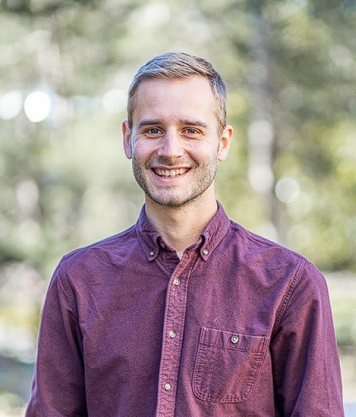
An expression of faith
The Pew Research Center results did not surprise Avery Lamb, co-executive director of Creation Justice Ministries, a Washington, D.C.-based organization that “educates, equips and mobilizes” Christian congregations and communions “to protect, restore and rightly share God’s creation.” Lamb said he often encounters the impact of politics in his work.
“The biggest difficulties we encounter are our own Christian siblings who have not come to understand environmental justice or creation care as an expression of their faith,” Lamb said.
He said he is sometimes asked what denomination is easiest to work with. “You know, it hardly ever plays out by specific denomination or specific theological tradition,” Lamb said. “It certainly plays out in terms of congregations that trend red or blue, especially when it comes to climate change. … Climate change is politically fraught in this country, and that doesn’t stop when you enter the church.”
Environmental justice seems to be one of the biggest hills to climb for faith leaders in the creation care movement, especially because talking about it brings up potentially divisive concepts such as systemic racism.
Similar to Pew’s seemingly contradictory findings on environmental issues, polling by the market research firm Ipsos in late 2021 showed a disconnect among people of faith on race and racism.

Language and politics as sticking points
Even language can make the work a particularly difficult sell, said the Rev. Mitchell C. Hescox.
“We don’t use the term ‘environmental justice,’” he said. “It has become a loaded progressive talking point in today’s world. What we talk about instead is bringing about fairness to front-line communities.”
As president of the Evangelical Environmental Network, Hescox travels the country spreading the message that people of faith have a special obligation to save the Earth and be kind to the environment. The Pennsylvania-based organization equips and mobilizes evangelical Christians to reclaim “the Biblical mandate to care for creation” and work toward “a stable climate and a healthy, pollution-free world,” according to its website.
Even in conservative communities, Hescox has had success convincing people of faith to be more concerned about the environment, he said. His most effective argument focuses on the impact of climate change on the next generation. “Everybody is concerned with their children and their grandchildren,” he said.
Environmental injustice does not happen only in communities populated by people of color, Hescox said. He noted that any community close to highways and factories or near mining operations, like some parts of Appalachia, can suffer serious health consequences from environmental factors.
Groups in the creation care movement often find success when environmental issues hit close to home. But not all churches feel the impact of environmental problems in their backyards. Across town from St. Ambrose, Greystone Baptist Church is in a mostly white neighborhood that is one of Raleigh’s most upscale areas and has never experienced the kind of human-caused environmental problems that the Episcopal parish has.
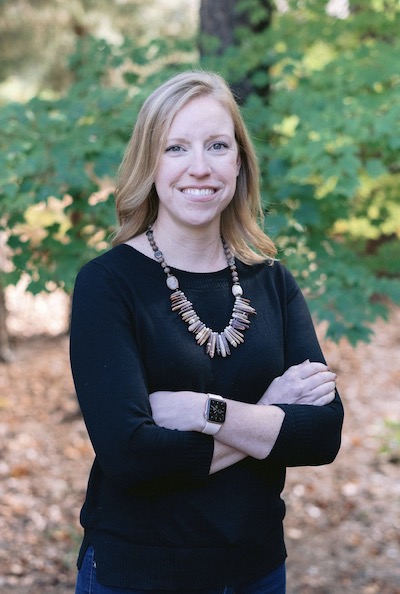
In May 2022, the Rev. Chrissy Tatum Williamson, Greystone’s senior pastor, gave a series of three sermons focusing on creation care. “I think it was the first time that we have spent three weeks on a topic that wasn’t what folks would think of as a traditional theological or ecclesiastical topic,” she said.
One sermon focused on the impact of Earth’s rising temperature. Warning the church to “buckle your seat belts” as she began, Williamson said people of faith must “repent and change the way we live.”
She concluded: “We have broken our covenant with God, the one that was given at creation when God gave us the Earth and called us to be stewards of the Earth, and the one that was renewed after the flood.”
As part of the series, Greystone took surveys of the congregation and had group discussions to get reaction. “I think it was received very well,” Williamson said of her congregation, which she describes as “theologically and politically diverse.”
Christian McIvor, the church’s minister of worship, music and the arts, agreed: “There was no pushback whatsoever.”
Williamson and McIvor note that a green lifestyle is well accepted at the church — for instance, recycling bins are prominent, and there is a composting operation out back.
But McIvor added that the church has not delved deeply into potentially more controversial topics. “To start thinking about the systemic nature of environmental injustice …that might raise some questions,” he said.
Healing and resurrection
St. Ambrose’s Taylor acknowledged that it’s easier for members of his church to embrace the environmental justice cause because of its location and history. For some congregations, creation care measures like installing solar panels and energy-saving devices are “cute,” he said. “If you didn’t do those things, your church would be OK. That’s not our reality.”
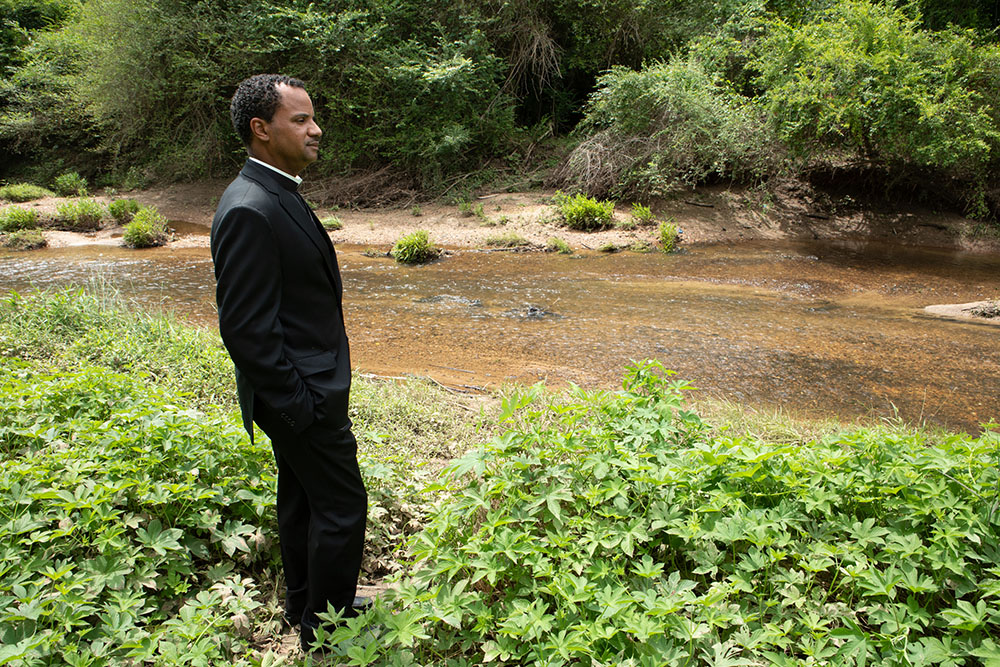
St. Ambrose has adopted such measures; the church has installed sun-blocking windows and water-saving toilets. But the most important work it has done, he said, has been cleaning up the nearby creek and surrounding wetlands.
“If we had not acted, this church would have been washed off its foundation,” Taylor said.
He said another factor is the vocal support from Episcopal Church leaders. The Episcopal Diocese of North Carolina has made creation care one of its five mission strategy priorities.
“When the top is talking like that, that sets the tone,” Taylor said.
The emphasis on creation care comes from the very top of the Episcopal Church. Presiding Bishop Michael Curry “made it really clear from the very start” that environmental justice would be an important focus for the church, according to the Rev. Melanie Mullen, the denomination’s director of reconciliation, justice and creation care.
How do individual green lifestyle choices mask our collective responsibility to address systemic environmental injustices? How do they inspire collective action?
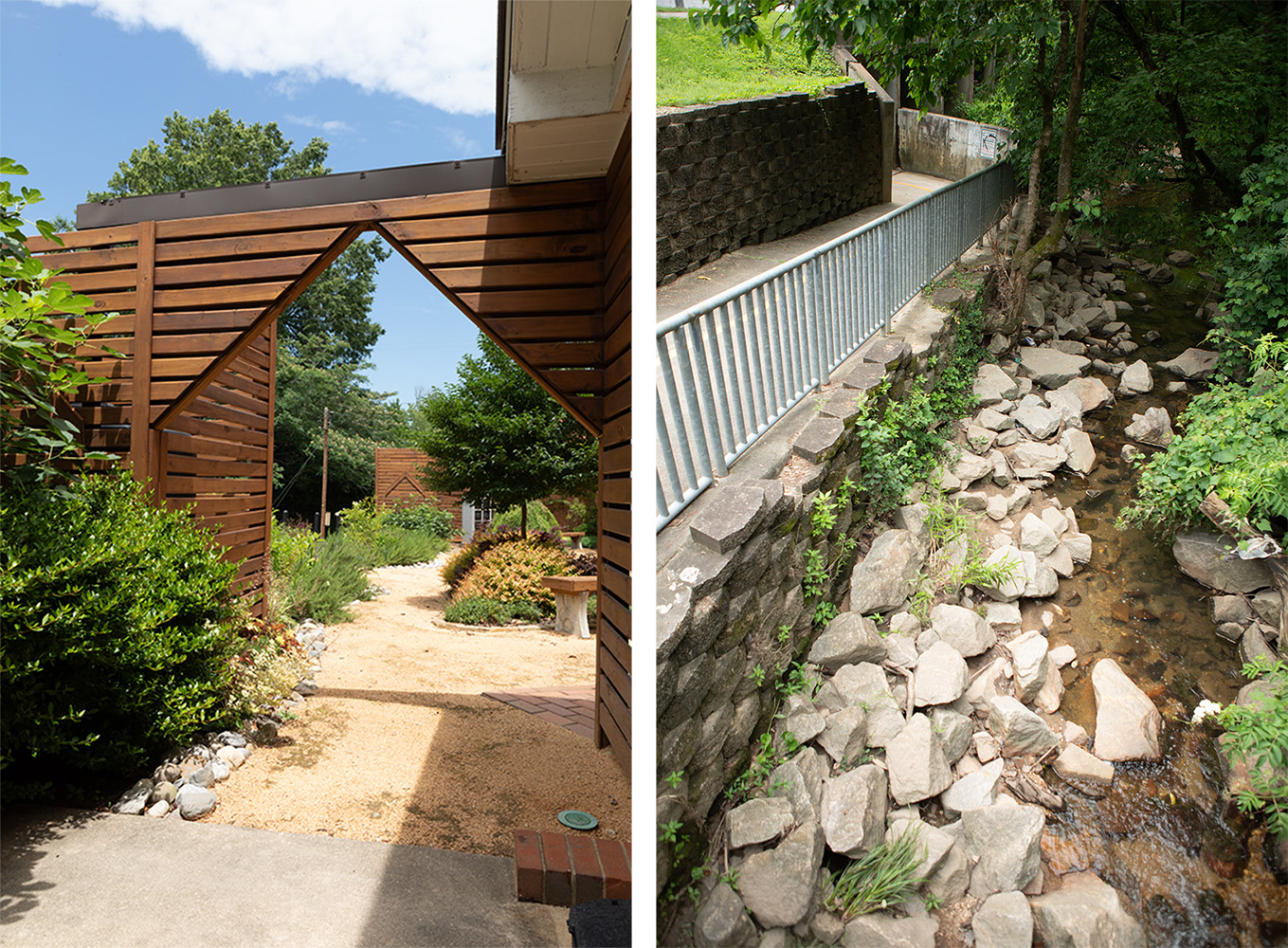
In 2017, the Episcopal Church began distributing grants for environmental projects around the country; since then, it has given out more than $800,000, Mullen said.
Projects with an environmental justice component are strong contenders for the grants, she said.
“We kind of lean into something we’re learning to express — we don’t give money for gardens,” she said, chuckling. “But we do encourage people to think seriously about relationships. The themes that we teach in racial relations we take seriously in environmental care. It’s great that you have a plan for solar panels or planting an orchard, but we ask that you show us that the grant works toward equity as well.”
The Episcopal Church has adopted a creation care covenant, and one of the pillars of that covenant is “liberating advocacy,” which the church describes in this way: “For God’s sake, standing alongside marginalized, vulnerable peoples, we will advocate and act to repair Creation and seek the liberation and flourishing of all people.”
“I think everyone’s learning to speak a language and acknowledge that there’s a commonality,” Mullen said. “We are stewards of this Earth, and we have to take care to leave no one behind. Our struggles are the Earth’s struggles. We come from different places, but everyone has to realize that in caring for the Earth, we are united.”
What can church leaders do to prioritize the climate emergency in the ministry of the church?
For Taylor, healing is an essential element of St. Ambrose’s environmental efforts. The church has made significant progress in abating the abuses of the past. Dumping has “subsided substantially” since cameras were affixed to light poles near the creek, he said. On a recent visit, the creek’s waters were clear and flowed freely; the banks were thick with vegetation.
“Having a resurrected wetlands heals the community from a mental and emotional standpoint,” he said. “I frame it through the lens of the resurrection. … The wetlands have been a victim of sin against God, against other people, against the land and against ourselves.”
The creek and the community may never be perfect, he said. But “as Christians, we hold up that vision of hope and work to make that more of a reality, realizing that we will not reach perfection until the second coming of Christ and the resurrection of the dead.”
How are environmental and racial injustices linked in your community? How can your congregation work with others in the community to hold these injustices together?

Questions to consider
- How does the interconnected harm of climate emergency and environmental injustice show up in the landscape of your church or the nearby land? How can your congregation participate in its healing?
- Who are our sources for wisdom in addressing racialized environmental injustice as we face a new climate reality that confronts all people with impacts of unsustainable pollution?
- How do individual green lifestyle choices mask our collective responsibility to address systemic environmental injustices? How do they inspire collective action?
- What can church leaders do to prioritize the climate emergency in the ministry of the church?
- How are environmental and racial injustices linked in your community? How can your congregation work with others in the community to hold these injustices together?
Low-status neighborhoods need talent retention. Instead, what they get is talent extraction, says Majora Carter.
“You are led to believe you need to leave — you need to measure success by how far you get away from there,” said Carter, a real estate developer and consultant who does work in her hometown neighborhood of Hunts Point in the South Bronx.
Carter, whose own family has experienced some of the ill effects of gentrification and predatory practices, has dedicated her efforts to building up her neighborhood and others.
Her projects include a local park and a coffee shop. In 2001, she founded Sustainable South Bronx, which aims to “achieve environmental justice through economically sustainable projects informed by community needs.” She also co-founded the Southern Bronx River Watershed Alliance and has been involved in numerous environmental and green jobs initiatives.
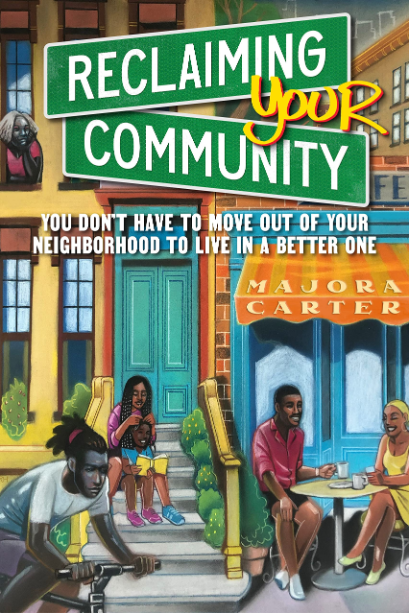
Carter wrote the book “Reclaiming Your Community: You Don’t Have to Move Out of Your Neighborhood to Live in a Better One” — which was endorsed by Lin-Manuel Miranda and Seth Godin — and gave a 2022 TED Talk on the same theme.
She is president of the Majora Carter Group, which offers consulting services in environmental assessment, compliance and planning. She has received many awards, including a 2005 MacArthur Foundation “genius grant” that described her as “a relentless and charismatic urban strategist” and New York University’s Martin Luther King Jr. Award for Humanitarian Service.
She spoke with Faith & Leadership’s Sally Hicks about her work in the South Bronx. The following is an edited transcript.
Faith & Leadership: Talk a little bit about the neighborhoods you work in and write about. You use the term “low-status” rather than more typical descriptors, and you actually begin your book with a glossary. Why?
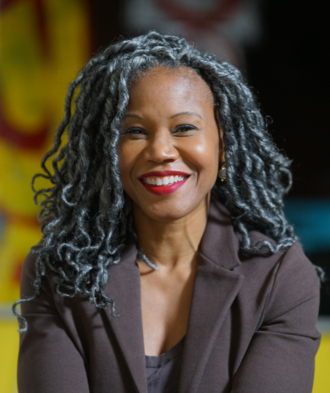
Majora Carter: Most folks, when they use “poor” or “underprivileged” or “underresourced,” blah, blah, blah — it implies poverty is there. “Low-status” implies something much larger and deeper is at work. There’s a high status and there’s a lower status, and inequality is simply assumed.
It’s the places where the health outcomes are lower, where the educational attainment is lower. Yes, poverty exists more frequently in those areas as well, and there’s often a lack of hope in terms of the future of the community, both for people in the neighborhood and outside it.
And it can be anywhere. Urban, rural, suburban. It can be inner cities, Native American reservations, white towns where there was some industry and it’s long gone.
What we see happening all the time is that the bright kids, the ones who are academically or artistically or even athletically inclined, are led to believe that they need to grow up and get out of those neighborhoods. That’s really the underlying thing that just everybody gets. I don’t care where they’re from.
That’s why our approach to community development is a talent retention strategy, really.
F&L: Part of this mindset is what you call the perception of “poverty as a cultural attribute.” The community can’t change — it isn’t changeable — and therefore the only solution is leaving.
MC: It’s baked in, this idea that poverty is part of the culture. So that’s what you plan for, whether you’re an elected planner, whether you’re an elected official or part of the “nonprofit industrial complex.” That is what you’re planning for.
There are several industries essentially that profit off that, and that’s what we’re trying to work against.
F&L: You use the term “nonprofit industrial complex.” What’s your critique of investment done according to traditional means?
MC: It’s a structure that was designed to take care of needs. But if we understand that and then we look at the money that’s being spent and we don’t see that the amount of money we spend is actually reducing all those social ills, then you kind of have to wonder, “Is it working?”
I’m not saying that [the nonprofit sector] doesn’t play a great role. It does. I’m just saying let’s just ask that question. Stop doing the exact same things over and over and over again.
Huge amounts of government-subsidized affordable housing [are built] for the lowest income bands. You’re not building economic diversity in any of the housing.
Health conditions happen because of the environmental abuses in the same neighborhoods, and we don’t address any of the underlying things but are managing the health conditions that are here, whether they’re diabetes, obesity, heart conditions. Then we are surprised that those numbers stay the same?
We all seem to be surprised every single year. It’s mind-boggling to me. I know I’m not the only person who sees this.
We’re managing poverty. We have plenty of systems to manage people and their poverty. It’s an incredibly paternalistic system that definitely has its roots in white supremacy that says, “You really will never be better, so we’re going to help you — not that much, but just enough.”
We keep seeing that over and over again, and yes, it does bother me very much.
F&L: What have you done in your own neighborhood, and what were you trying to accomplish with your projects?
MC: Ultimately, what I try to do is to help folks in my community, and communities like it, to not believe the narrative that our communities are places that are meant to be escaped from. We actually do have the capacity to revitalize our community from the inside out.
It started in my early work, when I was in the nonprofit sector for a number of years. I’ve always done project-based community development, because I’ve always felt the people needed to see and experience something different from what only screams poverty.
Again, the environment of our neighborhood literally often does say that. People know they need to leave their neighborhood in order to experience a nice park or a decent supermarket or a nice place to have a cocktail or a coffee with their friends.
What does it say about where you’re from? It says, “You don’t really need to be here if you have any sense of aspiration for yourself.” And most people do.
What I’ve tried to show is that we have wonderful things to offer people within our neighborhoods. The projects range from spearheading the development of the first waterfront park our neighborhood’s had in over 60 years. It was the only park — waterfront or not — that actually had grass and trees and the kind of places that made people feel, “Oh wait, this is a really special place to be.”
Then we did some work where we helped people have both a personal and a financial stake in the improvement of their environment. So we’ve created green-collar job training and placement systems.
F&L: Tell me about the cafe; that you’re sitting in right now while we’re talking on Zoom.
MC: In the early days, our work was more focused on consulting, but then it didn’t take us long to realize that it was really real estate development that we needed to be focused on.
We started in small multifamily [housing], and then we realized the other piece was lifestyle infrastructure. In part, we did that because it was nearly impossible for us to get the kind of financing that we needed to do larger projects. I didn’t really know much about real estate development, frankly, at the time.
But when we realized that what people were leaving the neighborhood to experience was places like cafes and coffee shops and things of that nature, we actually sort of used our own good credit. We made relationships with some of the local landowners that had businesses and got very, very reasonable rents on a couple of spaces in the commercial storefronts of their buildings.
We really wanted a cafe, because, again, we did an enormous amount of market research in the form of surveys and focus groups to understand what was it that made people feel good about being in their own neighborhood or not. Why were they leaving the neighborhood to experience something good?
So we got a lease, and we realized that most of the folks who wanted to build a cafe did not have the capacity to do it. We went to Starbucks, actually, and they were just like, “Nah. Your market is too emerging.”
That was really hard to hear, but then we ended up partnering with this awesome group called Birch Coffee, and we did a joint venture with them to open up our very first coffee shop. But it was also clear that we needed to be more about our own culture from the cafe’s perspective, and so that’s why we branched off into the Boogie Down Grind Café [in 2017] and rebranded ourselves.
It’s like an homage to hip-hop. Where I’m sitting right now, you take off the cushion and it becomes a stage, with a great big plate-glass window behind me so people can see it, for open mics or all sorts of wonderful things.
The day we were protested, we were hosting a workshop in this space for people who wanted low and 0% interest loans for either homeownership or for business development. It was kind of tragic and sad but ironic. But that’s what we did.
But those types of things — building out a space so that the community could come in and fill it and be seen in a cool place where people felt really good about how they looked — it was really fun, and we had a really nice time with it.
F&L: You mentioned a protest. You’ve gotten recognition for but also criticism of your work. Why do you think that is?
MC: Because Black girls from neighborhoods like this are not supposed to do this. I am acting way above my station, and I’m not supposed to do it.
We are just so duped into this idea that the only thing we can really be is just managed where we are, and that’s why [the detractors] behave that way.
I don’t know what they thought or what they think they’re getting out of it, but I no longer wish to continue to allow the idea that only a few companies around the country, in any city that you’re in, are the only ones. They’re almost always led by white men.
That’s why our communities are the way they are. I don’t feel that’s the only way our communities can develop — and why don’t we have that conversation?
But yeah, being a Black woman just paints another target on my head from everybody concerned.
F&L: I wanted to ask you just to clarify one thing. Several times you’ve said, “We did this. We did that.” When you refer to the “we,” are you referring to a development company?
MC: My company, yes. It’s interesting that I get that question. I really do think that it’s still hard for people to believe that I do this as a Black woman from a neighborhood like this. Of course I have a company. It’s small, but of course I have a company. I’m long on vision and short on balance sheet, but even functioning in that way, it’s still us, still doing the work of a developer.
F&L: What projects are you working on now?
MC: We’re redeveloping a commercial property, which is a former rail station. It’s a feasibility study to do an assemblage, which would be roughly 1,000 units of mixed-income housing, including homeownership, and about 400,000 to 500,000 square feet of manufacturing and commercial space.
That’s my dream. Literally, I want to be able to co-lead that project, and then I’ll retire. I will show that it can be done by someone who looks like me, and then I’ll walk. That is my prayer. Because I’m just too old. I’m going to be 60 in a few years, and I’m done. I’m not going to lie.
F&L: Even on Zoom, you do not look like someone who’s talking about retirement.
MC: Oh no, I am. I swear I’ve aged a lot over these past few years. I’m grateful. I know I’m blessed that I have the ability to do what I do. I’m still here, despite being smacked around as much as I’ve been. I can still smile and laugh about most of it — it makes me super, super happy — so that’s great.
F&L: If a congregation wants to do this kind of work, what would you recommend? I know you’ve worked with the Parish Collective organization.
MC: I was at the last Parish Collective [event]. I had actually been talking to a lot of them about, “What are the roles churches can play in development?”
If they do have property, how are they using it to support folks? More economically diverse communities are actually safer economically, socially. Spiritually as well.
But also really paying attention to predatory speculation. How do we support the homeowners that are already in those communities to keep them from falling victim to predators? I think churches can play a huge role in that, and so some of us are actually starting to have those conversations around it, which is great.
F&L: Do you come from a faith background?
MC: No, no. I am a Christian, definitely a follower. [But] I didn’t become a Christian until years later. I do feel like this is my ministry. And my ability to love my neighbor — I feel like this is my contribution. This is how I can give, and I love it.
